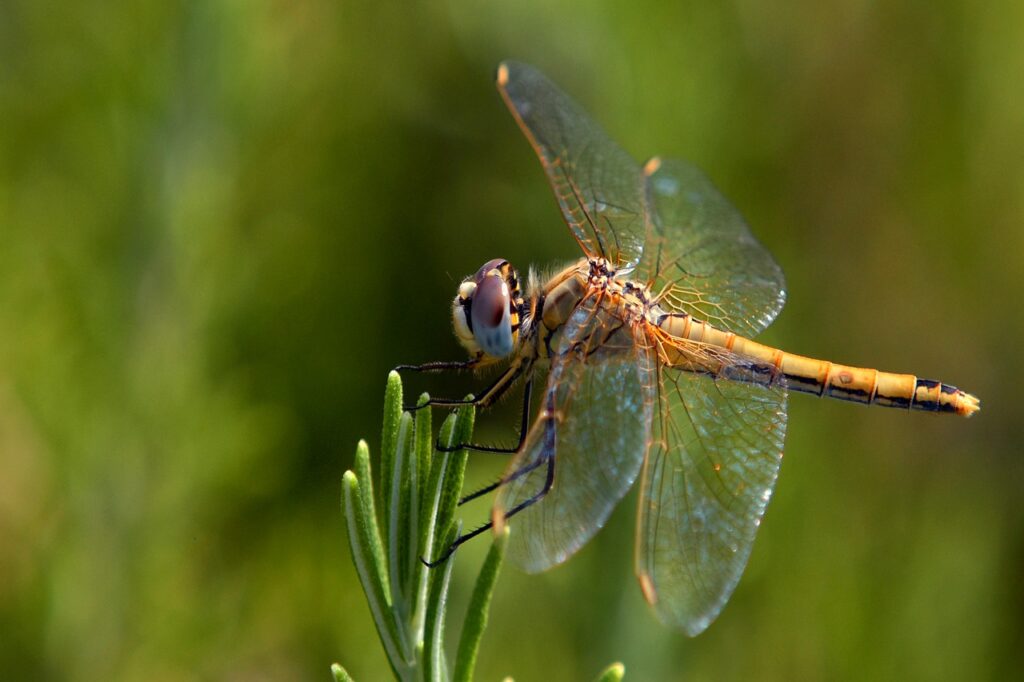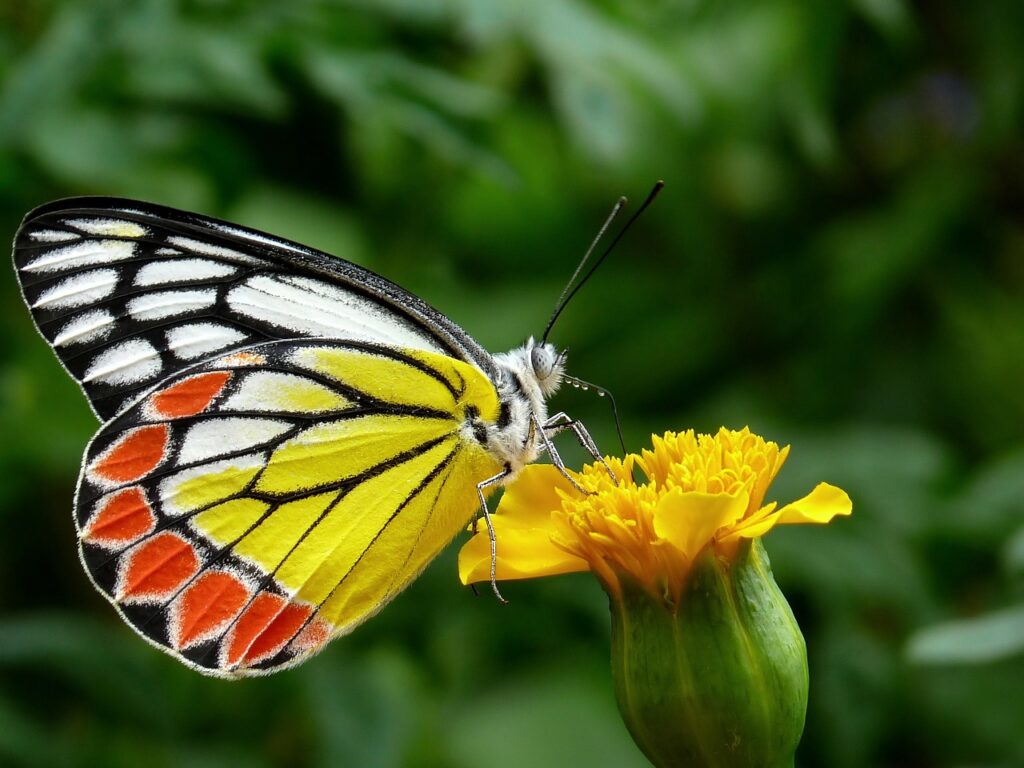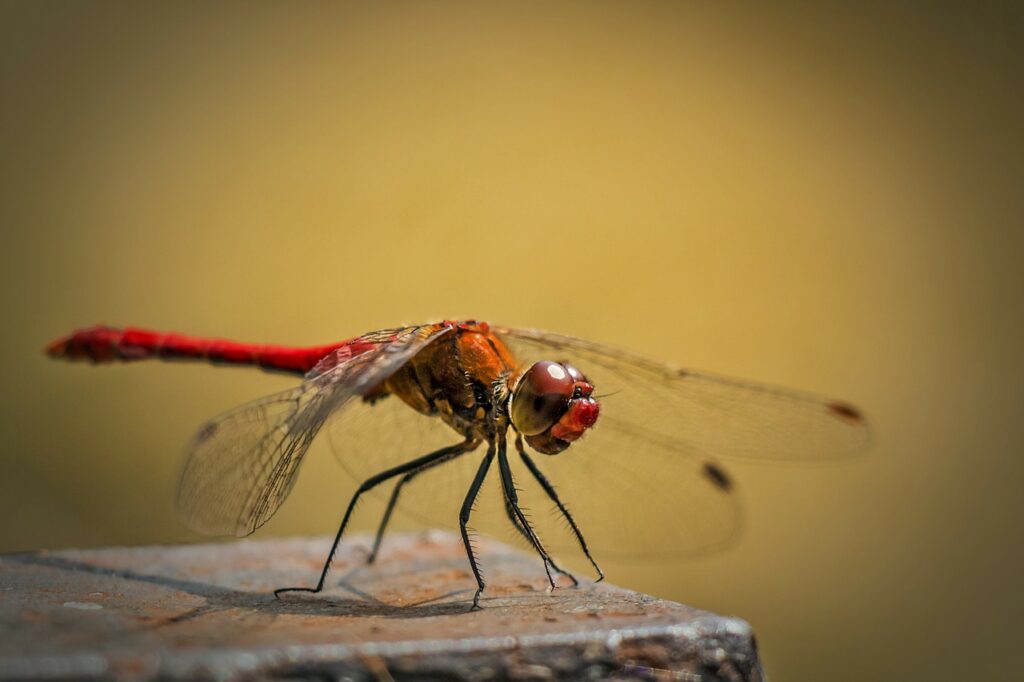Differences Between Dragonflies And Butterflies
The two most delightful insects to take to the skies are dragonflies and butterflies. Excellent colors, great patterns, bright radiance, and magical wings – but both different. They aren’t even closely related at all – and they both have very different double lives. The flying adult is just half the story – we need to take a closer look.
The 5 Easiest Ways To Tell Dragonflies And Butterflies Apart
1: Wings – Dragonflies have simple, transparent wings – butterfly wings are always brightly colored
2: Colors – Dragonflies bodies are brightly colored in rings and segments – but butterfly colors are 2D
3: Shape – Butterflies are all about the wings – but dragonflies have beautiful long bodies
4: Diet – Dragonflies are carnivores with strong jaws – butterflies drink nectar with their long curly tongue
5: Offspring – Dragonflies have predatory underwater larvae – butterflies create striking caterpillars
These might look good ways to distinguish them on paper – but you need to get outside and watch them in all their majesty. Sit yourself down on a sunny day by a pond in summer or close to delicate flowers in your garden at home, and wait. Anything that flies past you and lands on a leaf could be your chance to test your ID skills – but here are some more details to help you split them up.
1: Dragonflies And Butterflies Have Very Different Wings
The most apparent difference between the two is their wings. Both insects evolved completely differently and due to the different evolutions of these two groups – their methods of flight and position of the wings vary too. They do both have the same number of wings, though: 4 each. Dragonflies have their four wings attached to the tops of their backs at tiny connection points. Their wings are long, clear, veined, and thin, like fairy wings – and they keep them sticking out sideways when resting. In-flight, only their wings move, not their whole bodies – they can stay very still in the air.

Butterflies, on the other hand, are the opposite of both those things. When they fly, their whole body moves, twisting and turning through the sky like blossom on the wind – and gone in a flash on a tiny gust of wind. They also have their 4 wings close together on their sides, flapping together as one (although they can both be moved independently). They can also move them on top of each other and hold them together up over their backs – hiding their bright colors from predators.

2: The Color Of Dragonflies Is All On The Body. Butterflies: It’s On The Wings
Dragonflies and butterflies have their colors in different places – they evolved very differently in this respect too. With one family coming from the same branch as damselflies and mayflies; and the other from the same line as moths (which now has around 180,000 different species), there was bound to be variation. Butterflies live in a world of flowers, and so it seemed only right that they had an explosion of colors and patterns on their opened wings. A rich mosaic of colors across the species, including reds, yellows, oranges, blues, and purples, supports quite a dull brown or beige body that generally you won’t even notice.
Ranging from iridescent greens and blues, though deep reds, oranges, and pinks – these flying insects will surely catch your eye as they pass by. Dragonflies, however, have all their colors on their bodies – their wings might only have a colored tip if anything. They don’t hide their brightness either – they want to stay bright to show they are dangerous.
3: Dragonflies Have Very Long Segmented Bodies – Rather Than Being All Wing
Dragonflies are so old as a group that they flew with the dinosaurs – and they were just as big as dinosaurs. Their ancestors could have 70cm (28in) wingspans – compared to 10cm (4in) today. They are typical insects in that they have a segmented body with a head (which they can swivel around like a human), a thorax (where both sets of wings are anchored), and an obvious and long abdomen making up over half their body length.
Butterflies are insects too, but their 3 segments look quite different. They don’t have a neck at all, so their head meets the thorax, and their abdomen is less noticeable overall but is furry if you take a closer look. Butterflies are made to be wings – and the largest butterflies have up to 28cm (11in) wingspans to prove it—quite a size.
4: One Catches Insects In Mid Air – The Other Only Drinks Fluids
Dragonflies are born predators, and with their agility and precision in the air, they can hunt flying insects very well indeed. They have huge jaws for biting and chewing anything they find. Catching midges, mosquitos, and flies throughout the day, they hang around ponds and slow streams as this is where their prey is usually found in great numbers. Adult dragonflies only usually live for a few months, and so they need to work fast to build up their strength for the breeding season.
Butterflies are quite the opposite. They don’t have strong jaws – they don’t even technically have a mouth! They just have a very long tongue that they use as a straw – drinking nectar, sap, and rotting fruit mush. They keep their giant tongues rolled up under their chin, only straightening it for dipping inside deep flower cones. Butterflies are believed to be why there are so many different kinds of flowering plants because they co-evolved together over many millions of years.
5: Baby Dragonflies Are Hunters – Butterfly Babies Are Leaf Munchers
So famous are the butterflies ‘babies’ (technically their larval stage: insects go from the egg – larva – pupa – adult) that we call them caterpillars and love to see them – but not on our food or favorite plants. They are herbivores and munch away on leaves all night and day, making cute patterns and tiny nests of all shapes and sizes. Each caterpillar species has a particular food they eat, so they are often found on only one or two key plants – a great way to identify them too.
Dragonfly larvae are aquatic – and hunt tadpoles and fish as well as other underwater insects. They can live underwater for several years, growing strong enough to pupate into adults, and they have some fearsome faces under the microscope. As they are often called, dragonfly nymphs can feed on anything they fit in their mouths, so they can’t be identified in the same way as caterpillars can.
Frequently Asked Questions:
Do Butterflies And Dragonflies Hibernate?
Adult dragonflies only live for one season – as do most butterflies. The adult life stage of both insects is all about breeding – they make most of their living as larval stages (nymphs and caterpillars). However, quite a few butterflies can overwinter in sheds, barns, and houses. They almost completely shut down while waiting for the warmer weather – and their favorite flowers – to return the following spring. You often can’t see them, though, as the undersides of their wings are camouflaged to stop them from getting eaten while they sleep.
How Far Can Butterflies Fly?
The Monarch Butterfly (Danaus plexippus) can fly up to 3000 miles during its epic migration – covering all sorts of different terrains and through different environments. It is one of the longest migrations of any butterfly, and they travel in their millions each year from Mexico up through North America and back again the next year. Technically, these butterflies have also been in space (on the International Space Station), but they didn’t fly there themselves.
What Animal Eats Dragonflies?
Birds, namely the falcons, often take dragonflies. The Hobby (Falco subbuteo) – a tiny falcon – has them as the main food menu. They can also be caught by surface-feeding fish – who shoots a jet of water at adult dragonflies while they are sitting on the reeds or grasses at the water’s edge, knocking them into the water. Nymph dragonflies are eaten by a wide range of aquatic animals – well, those who are brave enough to catch them anyway!
Questions And Answers
Question: Do Dragonflies Only Live For A Day?
Answer: No. Adult dragonflies only have short lives – but even they are alive for at least a month. Some larger species can live over six years from the egg to the death of the adult – most of it spent underwater, though.
Question: Can You Keep A Pet Dragonfly?
Answer: Not really. Although many insects are kept as pets, dragonflies need specific foods and space as adults and breed. You can certainly keep larval dragonflies in indoor aquariums (as long as they are collected legally and aren’t endangered, of course).
Question: Do Dragonflies Eat Butterflies?
Answer: Yes, they can. Dragonflies will eat almost any insects they find flying through the air – although they prefer smaller insects in general. However, a hungry dragonfly will certainly catch anything to hand/wing.

